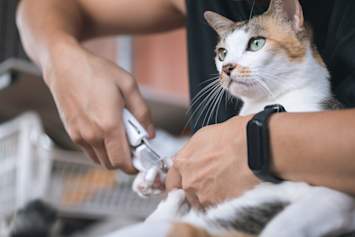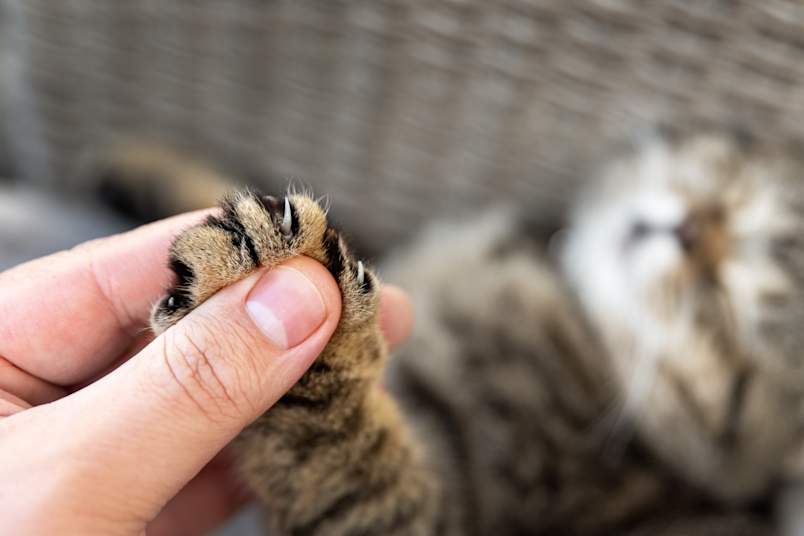
Even the most devoted cat parent can find themselves at odds with their feline companion's scratching habits. Scratching is a natural behavior for cats, but it can wreak havoc on your leather couch. So have you ever wondered, "how much does it cost to declaw a cat"? While the price tag might seem tempting, especially when your favorite chair is looking worse for wear, declawing is a controversial surgery with potential downsides for your feline friend. Only consider it as a last resort. Before you make a decision, let's explore the costs and procedures associated with declawing, as well as some effective alternatives that will keep your kitty happy and your furniture safe.
Cat Declawing: Costs and Procedures
Declawing should be a last resort after trying other methods. If, however, you and your veterinarian decide it's the best course of action, here's what you can expect regarding the cost. As with all surgical procedures, there can be quite a range in the cost to declaw a cat. In general, you can expect to pay anywhere from $200 to $1,800.
Factors Influencing the Cost of Declawing
Every surgery has a range of costs because every cat is different. You see, declawing requires anesthesia and pain medications, and the cat’s weight determines the dose needed. Now, most cats don’t vary in size as much as different dog breeds do, but if you have a 20 pound Maine Coon, you may end up paying more than if you have a teeny tiny Munchkin.
Age is another factor that affects the cost of declawing a cat. While most veterinary hospitals require bloodwork before they put an animal under anesthesia, some may require a bit extra for older kitties, so the cost may be higher.
The type of declawing procedure chosen can also impact the final cost. While all three methods aim to remove the third toe bone in each paw, they differ in technique and price:
Clipper Declawing: This method uses a specialized sterile clipper to remove the bone. It's generally the most affordable option but may lead to more bleeding and discomfort post-surgery.
Scalpel Declawing (Disarticulation): This method uses a scalpel to remove the bone and surrounding tissue. It can be slightly more expensive than clipper declawing but might offer better precision.
Laser Declawing: This method utilizes a laser to remove the bone, minimizing bleeding and potentially reducing post-operative pain. However, it's the most expensive option due to the specialized equipment required
Finally, remember that declawing costs can vary depending on your location. Veterinarians in bigger cities with higher operating costs may charge more compared to those in smaller towns.
How to Choose the Right Veterinarian
Declawing a cat should be a decision that you come to after you’ve exhausted all other methods of controlling where your cat scratches. Choose a veterinarian that understands this and helps you work through the alternatives first. If all else fails and you elect to declaw your cat, you also want that veterinarian to know what they’re doing in terms of presurgical bloodwork, monitoring, pain management, and aftercare.
Risks and Cons of Declawing Cats
Declawing seems like a win-win situation: your furniture stays intact, and your cat still gets to scratch. However, the reality is far less rosy. In this scenario, your couch might win, but your cat loses. To put it mildly, declawing is amputation—the surgery removes the last bone in the toe, which not only gets rid of the claw, but it also changes how a cat stands on their feet. These changes can cause lifelong pain in your feline friend. There is also the risk of infection since there are essentially 4-5 incisions in each paw that need to heal. Unfortunately, a cat’s paws have some dirty work to do both in and out of the litter box, which increases the risk of infection.
Depending on the surgery method, claws can even grow back, meaning that your furniture is no longer safe.
Potential extra costs add up to treat infections, pain, or even another surgery to remove that regrown claw. Some cats even develop anxiety or depression from the lasting pain, resulting in behavioral problems.

Alternatives to Declawing
Before signing that surgical release form, look into all the alternatives to declawing a cat. There are many options out there, so discuss any of these with your vet if you have any questions.
Regular nail trimming: Trim nails every couple of weeks.
Vinyl nail caps: These are a little controversial and do require some upkeep but can work well.
Appropriate scratching outlets: There are many options, so pay attention to the mediums that your cat likes and place the chosen scratcher in areas your cat normally uses.
Training: Once you have an appropriate scratching option, it’s time to train your cat to use it. Reward for good behavior, deter inappropriate behavior, and consult a professional behaviorist if necessary.
Provide enrichment: While scratching is a normal behavior, it can also be the result of boredom or stress in cats, so be sure you address these needs through exercise, play, and interaction. Identify stressors, remove them if possible, and look into pheromone therapy or calming sprays if necessary.
So, What About Declawing Your Cat?
Declawing cats often comes at a lifelong cost to their health and wellbeing. It’s not a decision to be taken lightly, so whether you’re researching how to take care of a kitten or have an older cat with a scratching problem, be sure to explore all of the alternatives to declawing a cat before considering the surgery.
Your veterinarian will be the best source of information as far as the pros and cons of declawing surgery and what alternative options you have. They can guide you through methods that address scratching behavior in a way that prioritizes your cat's well-being.
While you're making progress with training and alternatives, remember that accidents and illnesses can happen anytime. Don't let the cost and stress of unexpected vet visits distract you from the joy of your feline companion. Look into cat insurance. While they don't cover declawing (it's considered elective), pet insurance can provide peace of mind while you focus on helping your kitty.
An optional cat wellness plan can be a great tool to help you budget during this time. These plans can cover routine care like checkups and vaccinations, and even include the cost of seeing a behaviorist and nail trims! Regular nail trims are a key defense against future scratching damage and potential vet visits down the line. With cat insurance and a wellness plan, you can focus on creating a happy home for your cat without the worry of unexpected vet bills derailing your progress.
A happy cat is a purring, playful companion, enriching your life in countless ways. By taking the time to explore alternatives together, you'll strengthen the trust and connection with your furry friend, creating a lifetime of happy memories. You and your cat can absolutely thrive in a home that caters to both of your needs!